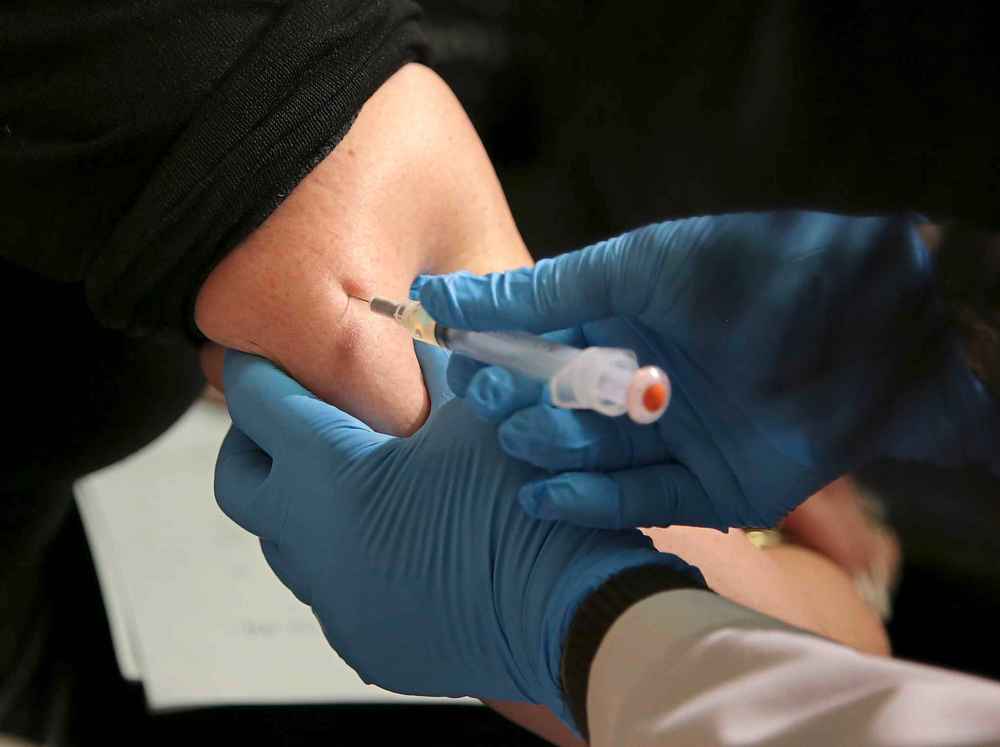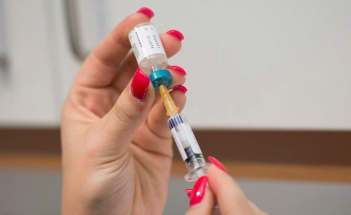Low vaccination rates troubling
Read this article for free:
or
Already have an account? Log in here »
To continue reading, please subscribe:
Monthly Digital Subscription
$0 for the first 4 weeks*
- Enjoy unlimited reading on winnipegfreepress.com
- Read the E-Edition, our digital replica newspaper
- Access News Break, our award-winning app
- Play interactive puzzles
*No charge for 4 weeks then price increases to the regular rate of $19.00 plus GST every four weeks. Offer available to new and qualified returning subscribers only. Cancel any time.
Monthly Digital Subscription
$4.75/week*
- Enjoy unlimited reading on winnipegfreepress.com
- Read the E-Edition, our digital replica newspaper
- Access News Break, our award-winning app
- Play interactive puzzles
*Billed as $19 plus GST every four weeks. Cancel any time.
To continue reading, please subscribe:
Add Free Press access to your Brandon Sun subscription for only an additional
$1 for the first 4 weeks*
*Your next subscription payment will increase by $1.00 and you will be charged $16.99 plus GST for four weeks. After four weeks, your payment will increase to $23.99 plus GST every four weeks.
Read unlimited articles for free today:
or
Already have an account? Log in here »
Hey there, time traveller!
This article was published 23/04/2019 (2425 days ago), so information in it may no longer be current.
It would be easy — but wrong — to deride St. Vital and Fort Garry as hotbeds of anti-vaxxers who reject scientific proof that vaccinations are effective, in the same way some conspiracy theorists believe the U.S. moon landing was faked.
Recent analysis of immunization data by Manitoba health officials found only 67 per cent of Winnipeg children born in 2008 got the recommended two doses of measles vaccine. The areas of lowest vaccination coverage are south Fort Garry at 58 per cent and north St. Vital at 55 per cent.
Officials are understandably alarmed because Winnipeg’s rate is far lower than the target of 90 to 95 per cent vaccination considered necessary for what virologists call “herd immunity.” What is less clear from the Manitoba study is why Winnipeg is letting down the herd.

It’s false to assume people opposed to vaccines are uninformed, paranoid or less intelligent, according to Joshua Greenberg, who led a 2017 study called Vaccine Hesitancy: In Search of the Risk Communication Comfort Zone. He found people who don’t vaccinate are often more educated than the general public.
“The anti-vaxxer is a spectre. It’s character in a narrative. We often inflate the degree of that problem,” Mr. Greenberg said in a recent interview.
Researchers found anti-vaxxers make up one to three per cent of the population. A larger category, 30 per cent of Canadians, are what researchers call “vaccine hesitant”: 27 per cent of that group worry vaccines might harm their children, and 33 per cent are suspicious of the pharmaceutical industry. Also, some vegetarians and vegans are concerned vaccines can contain traces of cow tallow, pork gelatin and egg yolk, and a few religious groups forbid vaccinations.

(function() {
var paidAccessCheck = function(){
if($(“.paidaccess”).css(“display”) == “block”){
var elements = Array.prototype.slice.call(document.querySelectorAll(“.g-artboard[data-min-width]”)),
widthById = {};
elements.forEach(function(el) {
var parent = el.parentNode,
width = widthById[parent.id] || parent.getBoundingClientRect().width,
minwidth = el.getAttribute(“data-min-width”),
maxwidth = el.getAttribute(“data-max-width”);
widthById[parent.id] = width;
if (+minwidth = width || maxwidth === null)) {
el.style.display = “block”;
} else {
el.style.display = “none”;
}
});
try {
if (window.parent && window.parent.$) {
window.parent.$(“body”).trigger(“resizedcontent”, [window]);
}
if (window.require) {
require([‘foundation/main’], function() {
require([‘shared/interactive/instances/app-communicator’], function(AppCommunicator) {
AppCommunicator.triggerResize();
});
});
}
} catch(e) { console.log(e); }
clearInterval(verifyPaidAccess);
}
}
var verifyPaidAccess = setInterval(paidAccessCheck,500);
// only want one resizer on the page
if (document.documentElement.className.indexOf(“g-resizer-v3-init”) > -1) return;
document.documentElement.className += ” g-resizer-v3-init”;
// require IE9+
if (!(“querySelector” in document)) return;
function resizer() {
var elements = Array.prototype.slice.call(document.querySelectorAll(“.g-artboard[data-min-width]”)),
widthById = {};
elements.forEach(function(el) {
var parent = el.parentNode,
width = widthById[parent.id] || parent.getBoundingClientRect().width,
minwidth = el.getAttribute(“data-min-width”),
maxwidth = el.getAttribute(“data-max-width”);
widthById[parent.id] = width;
if (+minwidth = width || maxwidth === null)) {
el.style.display = “block”;
} else {
el.style.display = “none”;
}
});
try {
if (window.parent && window.parent.$) {
window.parent.$(“body”).trigger(“resizedcontent”, [window]);
}
if (window.require) {
require([‘foundation/main’], function() {
require([‘shared/interactive/instances/app-communicator’], function(AppCommunicator) {
AppCommunicator.triggerResize();
});
});
}
} catch(e) { console.log(e); }
}
document.addEventListener(‘DOMContentLoaded’, resizer);
// feel free to replace throttle with _.throttle, if available
window.addEventListener(‘resize’, throttle(resizer, 200));
function throttle(func, wait) {
// from underscore.js
var _now = Date.now || function() { return new Date().getTime(); },
context, args, result, timeout = null, previous = 0;
var later = function() {
previous = _now();
timeout = null;
result = func.apply(context, args);
if (!timeout) context = args = null;
};
return function() {
var now = _now(), remaining = wait – (now – previous);
context = this;
args = arguments;
if (remaining wait) {
if (timeout) {
clearTimeout(timeout);
timeout = null;
}
previous = now;
result = func.apply(context, args);
if (!timeout) context = args = null;
} else if (!timeout && options.trailing !== false) {
timeout = setTimeout(later, remaining);
}
return result;
};
}
})();
.g-Layer_3 p {
text-shadow: 0px 1px 5px #fff;
}
#g-measles-box .g-artboard {
margin:0 auto;
}
#g-measles-box .g-artboard p {
margin:0;
}
.g-aiAbs {
position:absolute;
}
.g-aiImg {
display:block;
width:100% !important;
}
.g-aiSymbol {
position: absolute;
box-sizing: border-box;
}
.g-aiPointText p { white-space: nowrap; }
#g-measles-artboard-200 {
position:relative;
overflow:hidden;
}
#g-measles-artboard-200 p {
font-family:Open Sans,sans-serif;
font-weight:400;
font-size:10px;
line-height:12px;
filter:alpha(opacity=100);
-ms-filter:progid:DXImageTransform.Microsoft.Alpha(Opacity=100);
opacity:1;
letter-spacing:0em;
text-align:left;
color:rgb(0,0,0);
text-transform:none;
padding-bottom:0;
padding-top:0;
mix-blend-mode:normal;
font-style:normal;
height:auto;
}
#g-measles-artboard-200 .g-pstyle0 {
font-weight:700;
font-size:16px;
line-height:19px;
}
#g-measles-artboard-200 .g-pstyle1 {
font-size:16px;
line-height:19px;
}
#g-measles-artboard-200 .g-pstyle2 {
font-size:12px;
line-height:10px;
text-align:center;
}
#g-measles-artboard-200 .g-pstyle3 {
font-weight:700;
font-size:12px;
line-height:14px;
}
#g-measles-artboard-200 .g-pstyle4 {
font-weight:700;
font-size:12px;
line-height:14px;
text-align:right;
}
#g-measles-artboard-200 .g-pstyle5 {
line-height:14px;
}
#g-measles-artboard-400 {
position:relative;
overflow:hidden;
}
#g-measles-artboard-400 p {
font-family:Open Sans,sans-serif;
font-weight:400;
font-size:10px;
line-height:12px;
filter:alpha(opacity=100);
-ms-filter:progid:DXImageTransform.Microsoft.Alpha(Opacity=100);
opacity:1;
letter-spacing:0em;
text-align:left;
color:rgb(0,0,0);
text-transform:none;
padding-bottom:0;
padding-top:0;
mix-blend-mode:normal;
font-style:normal;
height:auto;
}
#g-measles-artboard-400 .g-pstyle0 {
font-weight:700;
font-size:16px;
line-height:19px;
}
#g-measles-artboard-400 .g-pstyle1 {
font-size:16px;
line-height:19px;
}
#g-measles-artboard-400 .g-pstyle2 {
font-size:12px;
line-height:19px;
text-align:center;
}
#g-measles-artboard-400 .g-pstyle3 {
font-weight:700;
font-size:16px;
line-height:19px;
text-align:right;
}
#g-measles-artboard-400 .g-pstyle4 {
line-height:14px;
}
#g-measles-artboard-650 {
position:relative;
overflow:hidden;
}
#g-measles-artboard-650 p {
font-family:Open Sans,sans-serif;
font-weight:400;
font-size:12px;
line-height:14px;
filter:alpha(opacity=100);
-ms-filter:progid:DXImageTransform.Microsoft.Alpha(Opacity=100);
opacity:1;
letter-spacing:0em;
text-align:left;
color:rgb(0,0,0);
text-transform:none;
padding-bottom:0;
padding-top:0;
mix-blend-mode:normal;
font-style:normal;
height:auto;
}
#g-measles-artboard-650 .g-pstyle0 {
font-weight:700;
font-size:16px;
line-height:19px;
}
#g-measles-artboard-650 .g-pstyle1 {
font-size:16px;
line-height:19px;
}
#g-measles-artboard-650 .g-pstyle2 {
text-align:center;
}
#g-measles-artboard-650 .g-pstyle3 {
font-weight:700;
font-size:16px;
line-height:19px;
text-align:right;
}
#g-measles-artboard-650 .g-pstyle4 {
font-size:10px;
}

Measles vaccination rates
Percentage of 2008 birth cohort receiving 2 of 2 doses
0 %
50
60
70
80
100
Seven Oaks
Inkster
Transcona
St. James
Downtown
Assiniboine South
St. Vital
St. Vital North
55%
Fort Garry South
58%
Source: Winnipeg Regional Health Authority

Measles vaccination rates
Percentage of 2008 birth cohort receiving 2 of 2 doses
0 %
50
60
70
80
100
Seven Oaks
Inkster
Transcona
St. James
Downtown
Assiniboine South
St. Vital
St. Vital North
55%
Fort Garry South
58%
Source: Winnipeg Regional Health Authority

Seven Oaks
Inkster
Measles vaccination rates
Percentage of 2008 birth cohort receiving 2 of 2 doses
Transcona
St. James
Downtown
Assiniboine South
0 %
50
60
70
80
100
St. Vital
St. Vital North
55%
Fort Garry South
58%
Source: Winnipeg Regional Health Authority
These people would have every right to refuse vaccinations and tell the rest of us to mind our own business, except for one factor: the greater good. Unvaccinated Winnipeggers can transmit the virus as they mingle in various places, including schools. That makes vaccinations everybody’s business.
When it comes to communicable infections, the delicate question of when personal rights can be trumped by the greater good invariably leads to the suggestion of mandatory vaccinations.
Ontario and New Brunswick require proof of immunization for children to attend school, although they make exceptions for medical, religious or ideological reasons.
At their annual conference last year, Manitoba school trustees defeated a motion to lobby the provincial government to make vaccination necessary for school entry. While the trustees’ regard for the rights of the individual is admirable, their vote did nothing to get more kids vaccinated.
Manitoba should give careful consideration to a strategy B.C. plans to introduce in September: not mandatory vaccinations, but mandatory reporting of vaccinations. Kids don’t need to be vaccinated, but schools need to know who is and who isn’t.
These records will let public health officials provide reliable information to families that didn’t vaccinate, and also follow up with parents who perhaps simply didn’t get around to it. Officials could also offer mobile clinics in areas of extremely low vaccination rates.

If B.C.’s model of mandatory reporting doesn’t help improve Winnipeg’s dangerously low vaccination rate, Manitoba should consider following the lead of Ontario and New Brunswick.
It’s the choice of parents not to vaccinate, but such choices have consequences, which can include unvaccinated children being kept away from others.
A better choice for parents is to get reliably informed about how vaccinations are in the best interest of both their children and the greater community.












